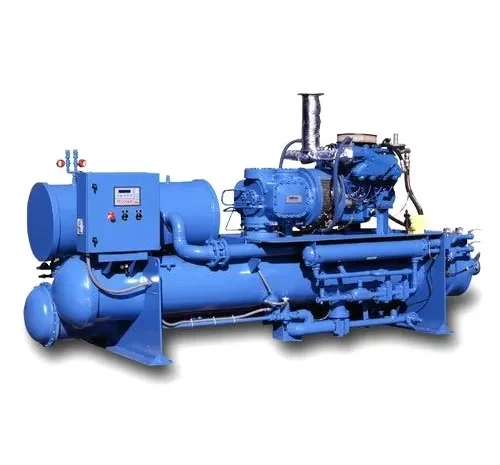Introduction
Each operates on a distinct principle, suited to specific energy sources and cooling requirements. Vapor compression chillers, the most common, rely on mechanical compression to circulate refrigerants and cool spaces efficiently, driven by electrical energy. Absorption chillers, on the other hand, utilize thermal energy sources—such as waste heat, natural gas, or even solar power—to perform the cooling cycle without a mechanical compressor. This makes absorption chillers particularly suitable for facilities that can harness excess heat from industrial processes or renewable sources. Understanding the pros and cons of each system type is essential for facility managers and engineers, as it impacts initial investment, operational costs, energy efficiency, and environmental footprint.
Vapor Compression Chillers

Vapor compression chillers operate using a cycle of evaporation and condensation, where a compressor circulates refrigerant through various stages. In this process, the refrigerant evaporates and absorbs heat from its surroundings, which cools the air or water being circulated. The compressor then compresses the refrigerant, raising its temperature, after which it releases heat as it condenses and moves through the condenser coil. This process repeats, efficiently cooling the space.
Pros:
- High Efficiency: Vapor compression chillers deliver consistent cooling at high efficiency, making them a preferred choice for energy-intensive environments. Their performance is often steady across varying cooling loads, making them ideal for facilities with fluctuating demands.
- Wide Range of Applications: These chillers can meet large cooling demands and are versatile enough for different industries, such as commercial buildings, manufacturing plants, and data centers.
- Lower Initial Costs: Compared to absorption chillers, vapor compression systems have a simpler design and lower upfront costs, making them accessible for a wider range of budgets.
- Compact Size: Vapor compression chillers are often smaller in footprint, which is advantageous for facilities with limited space or specific layout constraints.
Cons:
- High Electricity Demand: These systems are powered by electric compressors, which can increase energy expenses in regions with high electricity costs and limit use in facilities with restricted electrical capacity.
- Environmental Impact: Many vapor compression systems use high GWP refrigerants, which have a significant environmental impact if they leak. However, low-GWP refrigerants are becoming more common, helping to mitigate this concern.
- Noise Levels: Compressors in vapor compression chillers can produce noticeable noise, which may necessitate additional soundproofing, especially in noise-sensitive areas like hospitals or office buildings.
Absorption Chillers

Absorption chillers use a process driven by thermal energy rather than electricity to create a cooling effect. Typically, a heat source (such as natural gas, solar energy, or waste heat) heats a mixture of refrigerant and absorbent, commonly water and lithium bromide. This heating causes the refrigerant to evaporate, absorbing heat and creating a cooling effect. The absorbent then absorbs the refrigerant vapor, completing the cycle.
Pros:
- Energy Efficiency with Waste Heat: By utilizing waste heat from industrial processes, absorption chillers can be incredibly energy-efficient, especially in industries where excess heat is a byproduct, such as in manufacturing or power generation.
- Low Electrical Demand: Absorption chillers have minimal electrical needs, which is advantageous for facilities with high electricity costs or limited capacity. They can be a sustainable choice in areas with renewable heat sources.
- Environmentally Friendly: Many absorption chillers use water as a refrigerant, making them a safer and more eco-friendly option compared to systems using high-GWP refrigerants.
- Quiet Operation: Absorption chillers lack mechanical compressors, resulting in quieter operation, which is ideal for noise-sensitive facilities like educational institutions, hospitals, and office spaces.
Cons:
- Higher Initial Cost: Absorption chillers are typically more expensive to install, which can deter some facilities with tight budgets from adopting this technology.
- Lower Efficiency for Low-Temperature Applications: They are less effective in applications that require lower cooling temperatures, making them less versatile than vapor compression systems.
- Large Size and Complexity: These systems are often bulkier, requiring more space and complex installation. Additionally, they depend on a stable and continuous heat source, which may not be feasible in all settings.
- Longer Payback Period: Absorption chillers often require more time to recoup the initial investment, especially if waste heat or a low-cost heat source is not readily available.
Conclusion
choice between vapor compression and absorption chillers ultimately depends on a facility’s energy resources, budget, and sustainability goals. Vapor compression chillers offer high efficiency, flexibility, and lower initial costs, making them suitable for a wide range of applications, particularly where electricity is readily available and affordable. On the other hand, absorption chillers present a greener, quieter, and energy-efficient option, especially beneficial for facilities that can leverage waste heat or renewable thermal energy sources. Each system has its unique advantages and limitations, impacting factors like operational costs, environmental impact, and space requirements. As organizations increasingly prioritize energy efficiency and environmental responsibility, understanding the pros and cons of these chiller types becomes essential.
